
Grafting persimmons
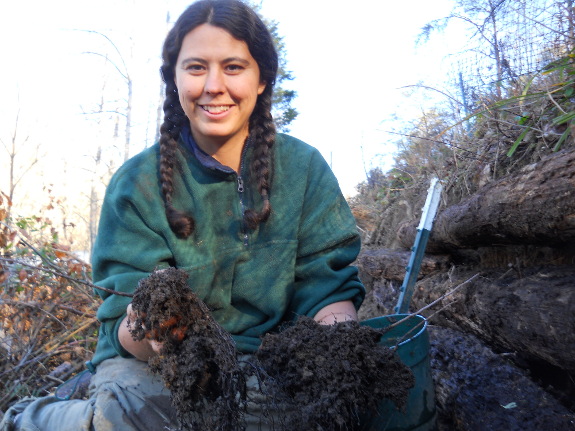 I set out ten persimmon seedlings in our chicken pastures 2.5 years ago,
figuring there were all kinds of experimental possibilities for the
young trees. Option 1 would be to simply let them grow up to adult size,
but a seedling persimmon has a 50/50 chance of being male (meaning no
fruit), grows very large, and takes a long time to bear. Option 2 (my
favorite at that time) was to graft hardy Asian persimmons onto the
seedling rootstocks...but my hardy persimmon varieties kept dying back
to the ground over the winter, so I decided to ditch that plan. Instead,
I moved on to option 3 --- to trade for named American persimmon
varieties (Yates, Proc, I-94, and Early Golden) and graft those onto my
seedling rootstocks.
I set out ten persimmon seedlings in our chicken pastures 2.5 years ago,
figuring there were all kinds of experimental possibilities for the
young trees. Option 1 would be to simply let them grow up to adult size,
but a seedling persimmon has a 50/50 chance of being male (meaning no
fruit), grows very large, and takes a long time to bear. Option 2 (my
favorite at that time) was to graft hardy Asian persimmons onto the
seedling rootstocks...but my hardy persimmon varieties kept dying back
to the ground over the winter, so I decided to ditch that plan. Instead,
I moved on to option 3 --- to trade for named American persimmon
varieties (Yates, Proc, I-94, and Early Golden) and graft those onto my
seedling rootstocks.
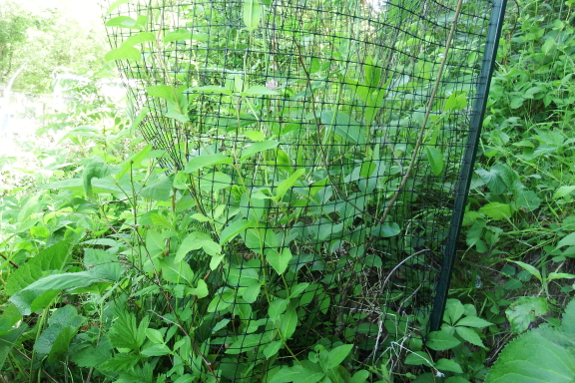
Persimmons are trickier
than some other fruits to graft, so I tried two different approaches. I
also followed the experts' advice by waiting until it seems far too late
to graft --- late May when the leaves on the seedling trees were nearly
fully formed.
The first step for both methods, though, was the same --- yank out the
weeds that had grown up within each tree's enclosure since the last time
I dropped by. Out in the chicken pastures, these little trees are lucky
to catch my eye more than once a year, so I wasn't surprised to find
that two of my seedlings had died and that one wasn't big enough to
graft onto. The rest --- despite being a bit winter-nipped from our -22
Fahrenheit cold spell --- had stems thick enough to graft onto.
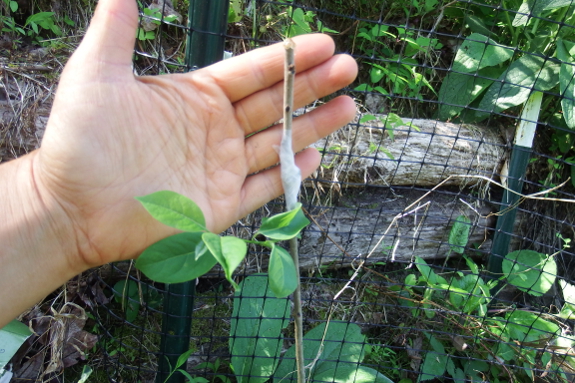
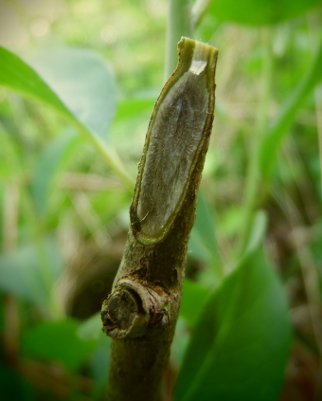 I grafted the first four plants before doing any research, so they got my usual whip-and-tongue graft.
It was definitely tougher to graft in situ than to bench graft, and
both the rootstock and scionwood were on the small side (compared to
apples) for most of the trees, so I'm not sure how many will take.
I grafted the first four plants before doing any research, so they got my usual whip-and-tongue graft.
It was definitely tougher to graft in situ than to bench graft, and
both the rootstock and scionwood were on the small side (compared to
apples) for most of the trees, so I'm not sure how many will take.
After I was done grafting, I still wasn't entirely sure what to do with
the existing growth on the trees. So I just cut the branches back but
left some leaves present to keep the tree alive until the graft union
heals. Again, I'm not sure if this was the best choice, or whether the
existing growth will prevent the graft union from healing. I guess time
will tell....
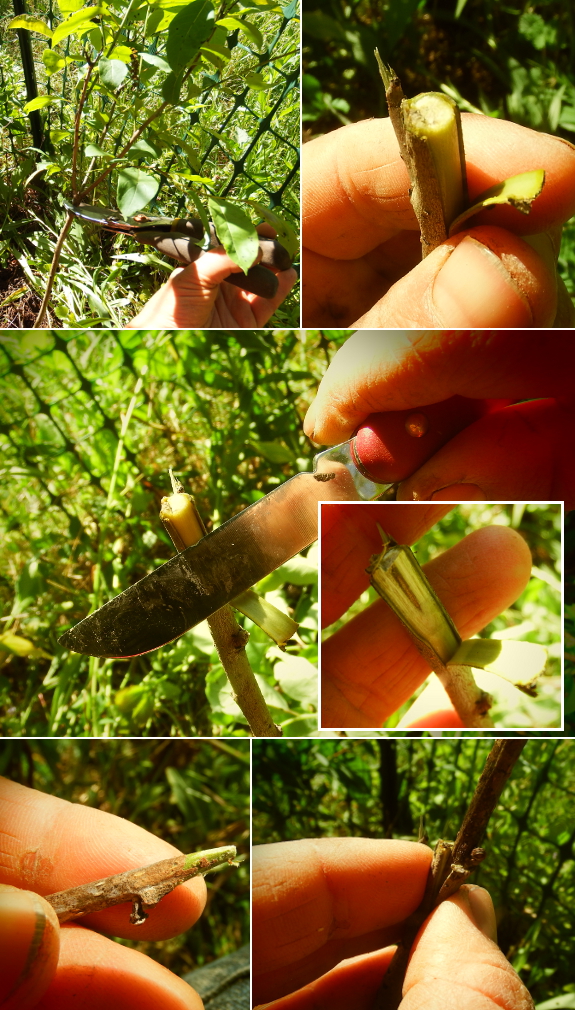
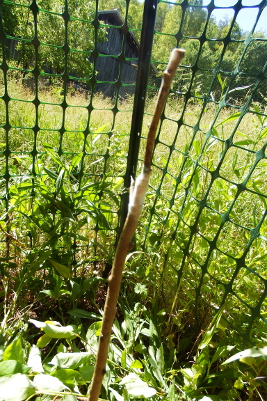 While I took a water break in front of the computer, I found this interesting file
suggesting an alternative method of grafting persimmons, so I followed
the author's lead for my last three trees. First, I snipped the entire
top off each seedling, then I slit a strip of bark and peeled it down
(carefully!) before cutting away a bit of the rootstock to make room for
another stick of wood to fit in.
While I took a water break in front of the computer, I found this interesting file
suggesting an alternative method of grafting persimmons, so I followed
the author's lead for my last three trees. First, I snipped the entire
top off each seedling, then I slit a strip of bark and peeled it down
(carefully!) before cutting away a bit of the rootstock to make room for
another stick of wood to fit in.
Next, it was time to prepare the scionwood by cutting one side of the
bottom at a slant and then using the knife blade to scrape the bark on
the rest of the bottom of the scionwood down to the green cambium. The
prepared scionwood slid under the rootstock's bark flap, and the whole
thing was wrapped with parafilm. (Okay, I didn't wrap my entire piece of
scionwood since that just seemed too extreme, but I may regret that
omission!)
With seven trees grafted to four varieties, I'm hopeful I'll see at
least a 50% success rate and will end up with several different types of
persimmons to continue their slow growth in the chicken pastures. Since
the trees there don't get much TLC, chances are I won't see fruit until
2020, but hopefully the results will be worth the (very little) effort
I've so far put into my experimental trees.
Want more in-depth information? Browse through our books.
Or explore more posts by date or by subject.
About us: Anna Hess and Mark Hamilton spent over a decade living self-sufficiently in the mountains of Virginia before moving north to start over from scratch in the foothills of Ohio. They've experimented with permaculture, no-till gardening, trailersteading, home-based microbusinesses and much more, writing about their adventures in both blogs and books.
Want to be notified when new comments are posted on this page? Click on the RSS button after you add a comment to subscribe to the comment feed, or simply check the box beside "email replies to me" while writing your comment.

Definitely wrap the whole graft in Parafilm!
I've had nearly 100% success with apples, if the whole graft and scion was wrapped in Parafilm if I ignore one particular stick of scion wood which failed a lot and one topworked tree which probably got baked the way I bagged it.
Wrap the while scion in Parafilm then wrap it in paper top protect from the sun, that seems ideal, one layer of paper seems good, but I try to fold it up on the north side and top to keep the bugs out.